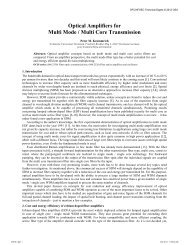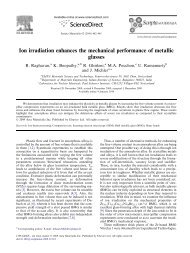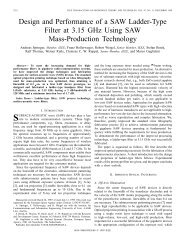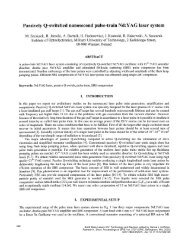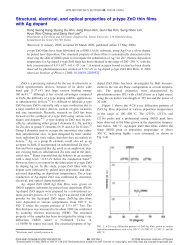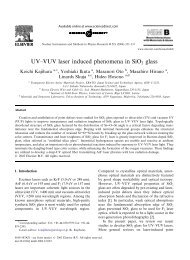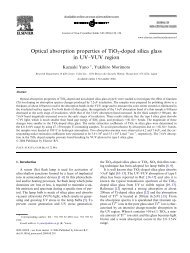Material properties of Cd1 x Mg x O alloys synthesized by radio ...
Material properties of Cd1 x Mg x O alloys synthesized by radio ...
Material properties of Cd1 x Mg x O alloys synthesized by radio ...
Create successful ePaper yourself
Turn your PDF publications into a flip-book with our unique Google optimized e-Paper software.
APPLIED PHYSICS LETTERS 103, 041902 (2013)<br />
<strong>Material</strong> <strong>properties</strong> <strong>of</strong> Cd 12x <strong>Mg</strong> x O <strong>alloys</strong> <strong>synthesized</strong> <strong>by</strong> <strong>radio</strong> frequency<br />
sputtering<br />
Guibin Chen, 1,2 K. M. Yu, 1,a) L. A. Reichertz, 1,3 and W. Walukiewicz 1<br />
1 <strong>Material</strong>s Sciences Division, Lawrence Berkeley National Laboratory, Berkeley, California 94720, USA<br />
2 Department <strong>of</strong> Physics and Jiangsu Key Laboratory for Chemistry <strong>of</strong> Low Dimensional <strong>Material</strong>s,<br />
Huaiyin Normal University, Jiangsu 223300, People’s Republic <strong>of</strong> China<br />
3 RoseStreet Labs Energy, Phoenix, Arizona 85034, USA<br />
(Received 27 February 2013; accepted 2 July 2013; published online 22 July 2013)<br />
We have studied structural, electrical, and optical <strong>properties</strong> <strong>of</strong> sputter deposited ternary Cd<strong>Mg</strong>O<br />
alloy thin films with total <strong>Mg</strong> concentration as high as 44%. We found that only a fraction<br />
(50%–60%) <strong>of</strong> <strong>Mg</strong> is incorporated as substitutional <strong>Mg</strong> contributing to the modification <strong>of</strong> the<br />
electronic structures <strong>of</strong> the <strong>alloys</strong>. The electrical and optical results <strong>of</strong> the Cd 1 x <strong>Mg</strong> x O<strong>alloys</strong>are<br />
analyzed in terms <strong>of</strong> a large upward shift <strong>of</strong> the conduction band edge with increasing <strong>Mg</strong><br />
concentration. With the increase <strong>of</strong> the intrinsic bandgap, appropriately doped Cd-rich Cd<strong>Mg</strong>O <strong>alloys</strong><br />
can be potentially useful as transparent conductors for photovoltaics. VC 2013 AIP Publishing LLC.<br />
[http://dx.doi.org/10.1063/1.4816326]<br />
Metal oxides have been extensively studied over the last<br />
two decades. 1–6 The reason for the wide interest in these<br />
materials is that they can be highly conductive and transparent<br />
over a wide wavelength region at the same time. Wide gap<br />
oxides such as In 2 O 3 :Sn (ITO) 7–10 or ZnO:Al (AZO) 11–13 are<br />
widely used as transparent contacts on thin film solar cells.<br />
An important limitation in the applications <strong>of</strong> these oxides is<br />
that they have significant long wavelength absorption and<br />
thus cannot be used for photovoltaics that utilize the infrared<br />
part <strong>of</strong> the solar spectrum. The poor infrared transmittance <strong>of</strong><br />
these materials can be attributed to the relatively strong ionized<br />
impurity scattering resulting in low mobility and large<br />
free carrier absorption. In addition, due to the high electron<br />
concentration in these materials (10 21 /cm 3 ) their plasma<br />
reflection edge typically occurs at wavelengths




